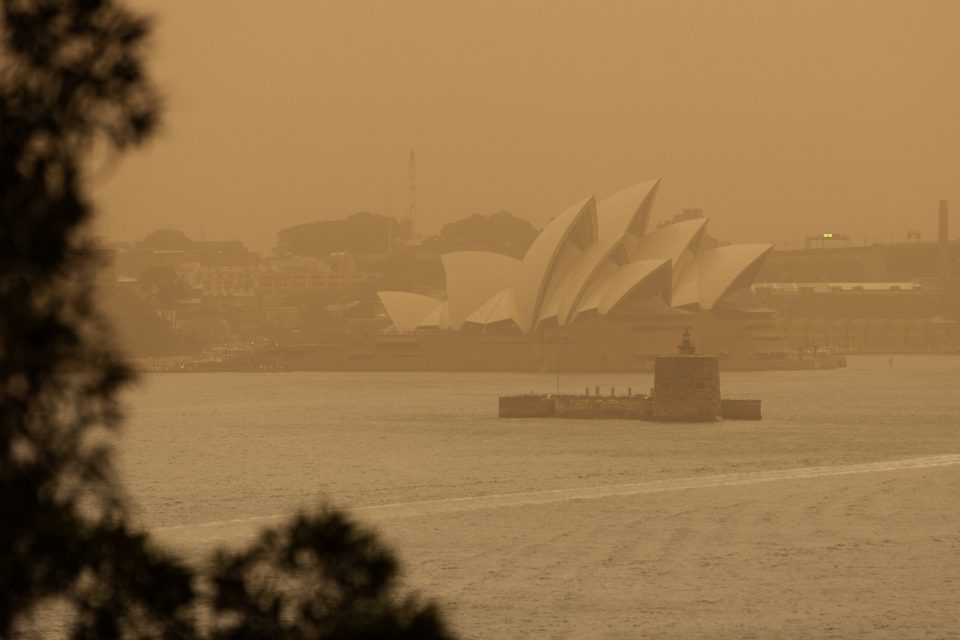The Sydney Opera House is seen as smoke haze from bushfires drifts over the CDB in Sydney, Australia, November 12, 2019. AAP Image/Paul Braven/via REUTERS

By Colin Packham
SYDNEY (Reuters) – Tens of thousands of Australians braced for a second day of high danger across the country’s east coast on Wednesday as scores of uncontrolled bushfires threatened several communities.
A cool change overnight brought some relief for firefighters in New South Wales (NSW) state after potentially “catastrophic” high winds and searing heat on Tuesday, when flames came within metres of homes in Greater Sydney.
Officials shifted their attention north on Wednesday morning to Queensland state, where temperatures are expected to hit 36 degrees Celsius (96.8 degrees Fahrenheit), which coupled with a change in wind direction, are expected to whip up flames there.
They also warned that despite success in dousing some of the NSW fires, nobody was yet completely safe with hotter and worse conditions forecast for next week.
Firefighters were battling blazes over a more than 1,000 km (620 mile) perimeter on Wednesday, with more than 1.1 million hectares (2.7 million acres) of land either burnt or burning.
“We will not have all these fires contained before then,” NSW Rural Fire Service Commissioner Shane Fitzsimmons told reporters in Sydney on Wednesday morning. “We will not have all these fires contained and locked up for many, many weeks.”
“Unfortunately, what we need is rain. What we need is meaningful rain. And there is certainly nothing in the forecast for the foreseeable future that’s going to make any discernible difference to the conditions that we are experiencing.”
Bushfires are a common and deadly threat in Australia’s hot, dry summers, but the ferocity and early arrival of this year’s outbreak in the southern hemisphere spring has caught many by surprise. They have so far claimed three lives and destroyed around 2.5 million acres of farmland and bush.
Blazes have been spurred by extremely dry conditions after three years of drought in parts of NSW and Queensland, which experts say has been exacerbated by climate change.
In Queensland, some 60 fires were burning, with four at a second-tier “watch and act” level, which advises locals of a heightened threat and the need to be prepared to evacuate.
Around 144 fires were still burning in NSW, with 16 out of control.
Temperatures in the state are expected to climb until the afternoon, along with accelerating winds.
Some 50 homes were destroyed in NSW on Tuesday, but no deaths were reported as warning systems and evacuation plans ahead of what officials said was the greatest threat in at least a decade appeared to save lives.
“It was just chewing up everything,” Karen Weston told Australian Broadcasting Corp of a fire near Taree on the mid-north coast.
“I’ve survived two other bushfires before this but never anything like this,” Weston said from an evacuation centre. “I’ve never seen anything like this.”
CLIMATE POLITICS
The fires have sparked increasingly acrimonious debate over Australia’s climate change policies, with the ruling conservative Liberal Party and the minor opposition Australian Greens exchanging barbs.
Former deputy prime minister and current lawmaker Barnaby Joyce was among those who have suggested that climate activists were at least partly responsible for the fires by lobbying to reduce so-called “back burns”, fires deliberately lit to clear out dry undergrowth.
Deputy Prime Minister Michael McCormack, meanwhile, said link between the fires and the government’s support of the coal industry were “the ravings of some pure, enlightened and woke capital city greenies.”
Prime Minister Scott Morrison, who has repeatedly declined to comment on climate change during the current crisis, called for moderation in the debate on Tuesday evening.
Fitzsimmons waded in on Wednesday, saying when asked: “We are mindful that the science is suggesting, and we are experiencing, that fire seasons are starting earlier and are extending longer,” he said. “There is no doubt that this drought is having a profound effect.”
(Reporting by Colin Packham and Sonali Paul; Editing by Stephen Coates and Jane Wardell)
Copyright 2018 Thomson Reuters. Click for Restrictions.


